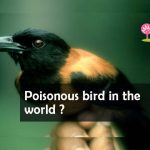Poisonous bird in the world ?

Birds are a species of warm-blooded vertebrates distinguished by feathers, toothless beaked jaws, hard-shelled eggs, a high metabolic rate, a four-chambered heart, and a sturdy but lightweight skeleton. Birds are present all over the world and range in size from 5.5 cm (2.2 in) bee hummingbirds to 2.8 m (9 ft 2 in) ostriches. There are approximately ten thousand living animals, with passerine, or “perching,” birds accounting for more than half of them.
The only identified groups of birds without wings are the extinct moa and elephant birds. Wings, which developed from forelimbs, allowed birds to fly, but further evolution has resulted in the loss of flight in some birds, including ratites, penguins, and a variety of endangered island species. Birds’ digestive and respiratory systems are also specifically designed for flight. Some aquatic bird species, especially seabirds and some waterbirds, have evolved swimming abilities. Birds are the only living dinosaurs and a group of feathered theropod dinosaurs.
Similarly, birds are considered reptiles in the modern cladistic sense of the word, and their closest living relatives are crocodilians. Birds are descended from the primitive avialans (including Archaeopteryx), which first appeared in China about 160 million years ago (mya). According to DNA data, modern birds (Neornithes) originated in the Middle to Late Cretaceous and diversified drastically around the time of the Cretaceous–Paleogene extinction event 66 million years ago, which wiped out pterosaurs and all non-avian dinosaurs.
Francis Willughby and John Ray established the first description of birds in their 1676 book Ornithologiae. Carl Linnaeus revised the work in 1758 to establish the taxonomic classification scheme that is still in use today. Formalized paraphrase In Linnaean taxonomy, birds are classified as the biological class Aves. Aves is classified as a dinosaur in phylogenetic taxonomy. Theropoda is a type of dinosaur.
Mind-Blowing Facts about Birds
- A flamingo will only feed when its head is turned upside down.
- The robin was voted the most common wild bird in the United Kingdom.
- The Ostrich is the world’s largest living bird, reaching a height of up to 2.7 metres and a wingspan of up to 2 meters (quite remarkable for a bird that can’t fly). It should come as no surprise that the Ostrich lays the largest bird eggs, which can weigh up to 1.5 kilograms.
- The world’s tiniest living bird is…the hummingbird, specifically the Bee Hummingbird, which is just 5.5 centimetres long and weighs no more than 1.9 grammes. Another interesting thing about this bird is that it lays the tiniest eggs, which are the size of a pea.
- When a bird is resting, its heart beats 400 times per minute, and when flying, it can beat up to 1000 times per minute.
- The Hooded Pitohui of Papua, New Guinea, is the only known poisonous bird in the world. Its skin and feathers contain the toxin.
- Pigeons served as the world wars’ radios. Due to the unreliability and simplicity of man-made communication systems, it fell to the humble pigeon to carry thousands of messages from the front lines. During both World Wars, over 300,000 pigeons were used, with 32 winning The Dickin Medal – the animal world’s Victoria Cross.
- The fastest bird on the planet is…the Peregrine Falcon, which can achieve a maximum recorded airspeed of 389 km/h during a hunting dive (242 mph).
- The African Gray Parrot is the world’s most chatty bird. About 800 words may be said by a single parrot. Most parrot species can only learn 50 terms.
- The world’s rarest bird is…a duck called the Madagascar Pochard, of which only 25 are known to exist in the wild. (The domestic chicken is the most common.)
- Owls can turn their heads nearly 360 degrees (a full circle), but their eyes cannot move.
- Since kiwi birds are blind, they hunt by scent.
- Swiftlet nests are a very costly food item in some countries, such as China. These birds make their nests out of hardened saliva. Nest soup is made from these eggs. It is also known as the “Easter Caviar.” A single kilogram will cost anywhere between $2500 and $100,000. A single bowl of swiftlet soup will cost anywhere between $30 and $100.
















